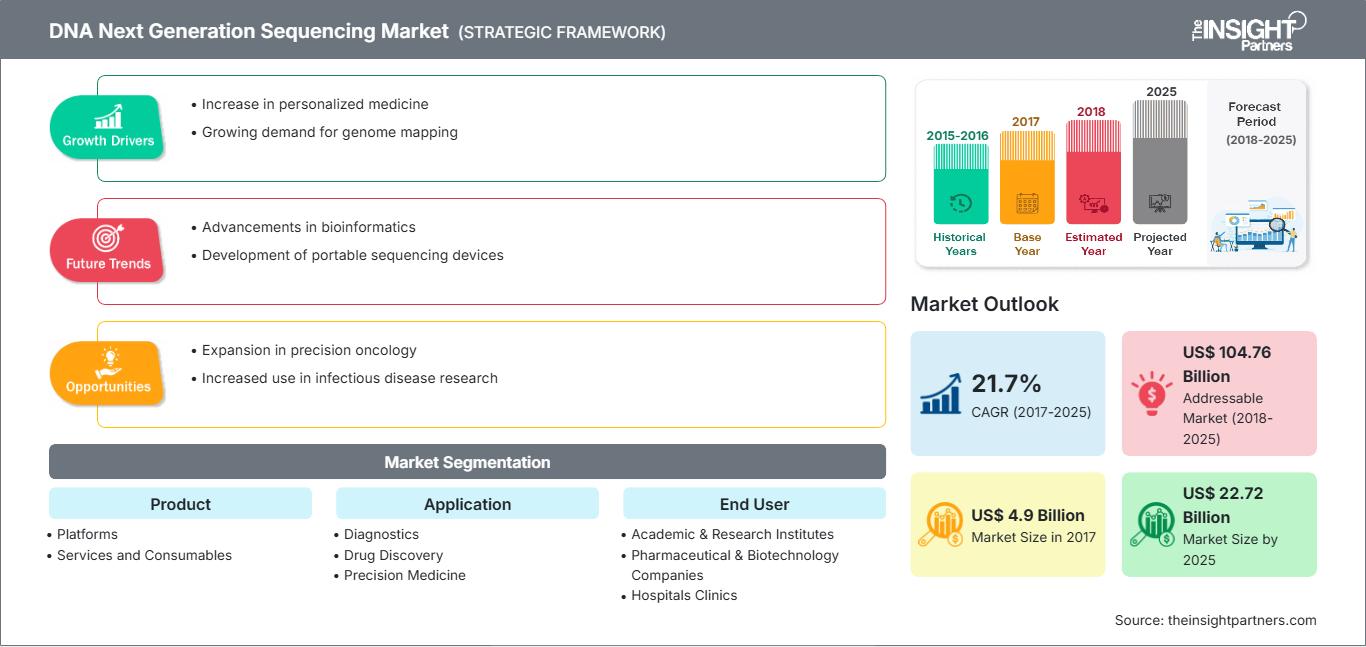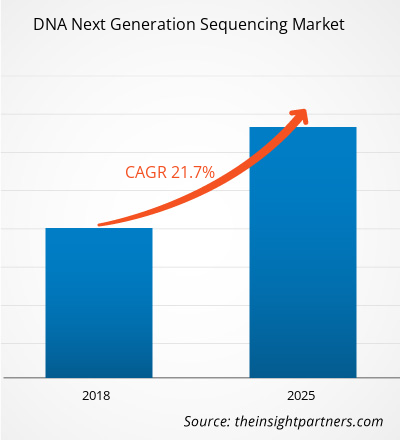[Forschungsbericht]Der Markt für DNA-Sequenzierung der nächsten Generation wird voraussichtlich von 4.898,5 Millionen US-Dollar im Jahr 2017 auf 22.716,9 Millionen US-Dollar im Jahr 2025 anwachsen; für den Zeitraum 2018–2025 wird ein durchschnittliches jährliches Wachstum von 21,7 % erwartet.
Sequenzierung der nächsten Generation wird auch als Hochdurchsatzsequenzierung bezeichnet. NGS ermöglicht die schnelle Sequenzierung der Basenpaare in DNA-Proben. NGS treibt die Anwendung in der Arzneimittelforschung voran und ermöglicht die Zukunft der personalisierten Medizin, genetischer Erkrankungen und der klinischen Diagnostik. Darüber hinaus ist Next-Generation-Sequenzierung (NGS) eine massiv parallele Sequenzierungstechnologie, die die Reihenfolge der Nukleotide in einem gesamten Genom skalierbar, mit ultrahohem Durchsatz und hoher Geschwindigkeit bestimmen kann. Da sie die Vorbereitung der Probe für die nachfolgende Sequenzierungsreaktion umfasst, ist die DNA-Vorsequenzierung einer der wichtigsten Prozesse im gesamten Sequenzierungsprotokoll. Im globalen Gesundheitssektor wird NGS zunehmend in klinische Laboranalysen, Tests und Krankheitsdiagnosen integriert. In der Pharmakogenomik wird NGS häufig eingesetzt, um den Prozess der Arzneimittelforschung zu beschleunigen.
Das Marktwachstum für DNA-Next-Generation-Sequenzierung ist auf die weltweit steigende Zahl von Krebsfällen, die Zunahme von Forschungsstudien, die zunehmende Zusammenarbeit zwischen Forschungsinstituten und Marktteilnehmern sowie die zunehmende Anwendung von DNA-Next-Generation-Sequenzierung und den technologischen Fortschritt in der Sequenzierungstechnologie zurückzuführen. Es wird jedoch erwartet, dass der Mangel an qualifizierten Fachkräften das Gesamtmarktwachstum für DNA-Next-Generation-Sequenzierung entscheidend beeinflussen wird.
Passen Sie diesen Bericht Ihren Anforderungen an
Sie erhalten kostenlos Anpassungen an jedem Bericht, einschließlich Teilen dieses Berichts oder einer Analyse auf Länderebene, eines Excel-Datenpakets sowie tolle Angebote und Rabatte für Start-ups und Universitäten.
Markt für DNA-Sequenzierung der nächsten Generation: Strategische Einblicke

- Holen Sie sich die wichtigsten Markttrends aus diesem Bericht.Dieses KOSTENLOSE Beispiel umfasst Datenanalysen, die von Markttrends bis hin zu Schätzungen und Prognosen reichen.
Sie erhalten kostenlos Anpassungen an jedem Bericht, einschließlich Teilen dieses Berichts oder einer Analyse auf Länderebene, eines Excel-Datenpakets sowie tolle Angebote und Rabatte für Start-ups und Universitäten.
Markt für DNA-Sequenzierung der nächsten Generation: Strategische Einblicke

- Holen Sie sich die wichtigsten Markttrends aus diesem Bericht.Dieses KOSTENLOSE Beispiel umfasst Datenanalysen, die von Markttrends bis hin zu Schätzungen und Prognosen reichen.
Markteinblicke
Sinkende Preise für Sequenzierung und technologische Fortschritte bei Sequenzierungsmethoden treiben den Markt für DNA-Sequenzierung der nächsten Generation an
In den letzten Jahren sind die Preise für DNA-Sequenzierung der nächsten Generation erheblich gesunken. Im Jahr 2000 betrugen die Kosten für die Sequenzierung des menschlichen Genoms 3,7 Milliarden US-Dollar und dauerten 13 Jahre. In den letzten Jahren sanken die Kosten jedoch auf 10 Millionen US-Dollar im Jahr 2006 und sanken 2012 weiter, und der Prozess dauerte weniger Tage. Große Akteure auf dem Markt für DNA-Sequenzierung der nächsten Generation wie Illumina und Roche haben bahnbrechende Technologien eingeführt, die kosteneffizient sind und weniger Zeit für Sequenzierungsprozesse benötigen.
Darüber hinaus haben Fortschritte auf dem Gebiet der Molekularbiologie die Sequenzierungsverfahren gleichermaßen verbessert. Viele Branchenakteure haben in den letzten Jahren innovative NGS-Technologien entwickelt. Zum Beispiel Pacific Biosciences mit Sequel und Oxford Nanopore mit PromethION. Darüber hinaus dominieren drei fortschrittliche NSG-Systeme den Markt: Roche GS FLX (454), Illumina HiSeq 2000 (Solexa) und AB SOLiD (Agencourt).
Die weitere Modifikation und Automatisierung dieses Prozesses führte zu einer weiteren Zunahme der Sequenzierungsdaten und einem effizienteren Zeitmanagement, sodass Forscher wichtige Meilensteine im Humangenomprojekt erreichen konnten. NGS macht die sequenzbasierte Genexpressionanalyse zu einer „digitalen“ Alternative zu analogen Techniken. Fortschritte in der Genomsequenzierung haben die Sequenzierung einfach und genau gemacht. Diese technologischen Fortschritte werden den Markt für DNA-Sequenzierung der nächsten Generation in naher Zukunft voraussichtlich stark vergrößern.
Produktbasierte Erkenntnisse
Der globale Markt für DNA-Sequenzierung der nächsten Generation ist produktbezogen in Plattformen, Dienstleistungen und Verbrauchsmaterialien unterteilt. Das Plattformsegment ist weiter unterteilt in HiSeq Series, MiSeq Series, SOLiD, Ion Torrent, Pacbio Rs II und Sequel Systems und andere. Das Servicesegment ist weiter unterteilt in Sequenzierungsdienste und Datenverwaltungs- und -analysedienste. Das Verbrauchsgütersegment ist zudem weiter unterteilt in Probenvorbereitung und andere NGS-Verbrauchsgüter. Das Verbrauchsgütersegment hatte 2017 einen größeren Anteil an den Produktuntersegmenten im Markt für DNA-Sequenzierung der nächsten Generation und dürfte im Prognosezeitraum einen ähnlichen Trend aufweisen. Neuere NGS-Plattformen haben eine neue Sequenzierungsmethode namens Einzelmolekülsequenzierung (SMS) übernommen, die keine vorherige Amplifikation von DNA erfordert und somit PCR-bedingte Fehler beim Lesen oder eine Amplifikationsverzerrung in Richtung Wiederholungsregionen vermeidet. In den letzten fünf Jahren hat die Sequenzierung der nächsten Generation (NGS) den Übergang von der Forschung zur klinischen Anwendung vollzogen. Mindestens 14 Länder haben Initiativen zur Sequenzierung großer Bevölkerungsgruppen ins Leben gerufen und Prognosen zufolge wird bis 2025 das Genom von über 60 Millionen Menschen weltweit sequenziert sein.
Anwendungsbasierte Erkenntnisse
Der globale Markt für DNA-Sequenzierung der nächsten Generation ist nach Anwendung segmentiert in Diagnostik, Arzneimittelforschung, Präzisionsmedizin und andere Anwendungen. Das Diagnostiksegment hatte 2017 den größten Anteil und dürfte in den nächsten fünf bis sechs Jahren deutlich wachsen. Der Einsatz von Next-Generation-Sequencing-Technologie (NGS) in der diagnostischen Genomversorgung erfordert Präzision und Genauigkeit. Die NGS-Technologien nutzen kosteneffiziente Sequenzierung, um aus der Gesamtgenomsequenzierung genomische Informationen über die Patienten zu gewinnen und klinische Maßnahmen durchzuführen. Next-Generation-Sequencing wird zunehmend konventionelle Technologien zur Diagnose verschiedener genetischer Störungen ersetzen. Große Genmengen können nun in einem einzigen Test analysiert werden, anstatt Gen für Gen zu analysieren.
Endnutzerbasierte Erkenntnisse
Der globale Markt ist nach Endnutzern segmentiert in akademische und Forschungsinstitute, Pharma- und Biotechnologieunternehmen, Krankenhäuser und Kliniken sowie andere Endnutzer. Das Segment der akademischen und Forschungsinstitute wird im Prognosezeitraum voraussichtlich das höchste Wachstum verzeichnen. Die Sequenzierung hilft Wissenschaftlern, die Art der genetischen Informationen zu identifizieren, die in einem bestimmten DNA-Abschnitt enthalten sind. So können Wissenschaftler beispielsweise anhand von Sequenzinformationen bestimmen, welche DNA-Abschnitte Gene enthalten und welche Abschnitte regulatorische Anweisungen zum An- oder Abschalten von Genen enthalten. Der automatisierte, industrialisierte Ansatz basierend auf Zufalls- oder Shotgun-Sequenzierung wurde vom Institute for Genomic Research (TIGR) in Rockville, Maryland, eingeführt und führte zur Veröffentlichung von 337 neuen menschlichen Genen und 48 homologen Genen aus anderen Organismen.
DNA Next Generation SequencingRegionale Einblicke in den Markt für DNA-Sequenzierung der nächsten Generation
Die Analysten von The Insight Partners haben die regionalen Trends und Faktoren, die den Markt für DNA-Sequenzierung der nächsten Generation im Prognosezeitraum beeinflussen, ausführlich erläutert. In diesem Abschnitt werden auch die Marktsegmente und die geografische Lage in Nordamerika, Europa, dem asiatisch-pazifischen Raum, dem Nahen Osten und Afrika sowie Süd- und Mittelamerika erörtert.
Umfang des Marktberichts zur DNA-Sequenzierung der nächsten Generation
| Berichtsattribut | Einzelheiten |
|---|---|
| Marktgröße in 2017 | US$ 4.9 Billion |
| Marktgröße nach 2025 | US$ 22.72 Billion |
| Globale CAGR (2017 - 2025) | 21.7% |
| Historische Daten | 2015-2016 |
| Prognosezeitraum | 2018-2025 |
| Abgedeckte Segmente |
By Produkt
|
| Abgedeckte Regionen und Länder | Nordamerika
|
| Marktführer und wichtige Unternehmensprofile |
|
Dichte der Marktteilnehmer im Bereich DNA-Sequenzierung der nächsten Generation: Verständnis ihrer Auswirkungen auf die Geschäftsdynamik
Der Markt für DNA-Sequenzierung der nächsten Generation wächst rasant. Die steigende Nachfrage der Endverbraucher ist auf Faktoren wie veränderte Verbraucherpräferenzen, technologische Fortschritte und ein stärkeres Bewusstsein für die Produktvorteile zurückzuführen. Mit der steigenden Nachfrage erweitern Unternehmen ihr Angebot, entwickeln Innovationen, um den Bedürfnissen der Verbraucher gerecht zu werden, und nutzen neue Trends, was das Marktwachstum weiter ankurbelt.

- Holen Sie sich die Markt für DNA-Sequenzierung der nächsten Generation Übersicht der wichtigsten Akteure
Produkteinführungen und -zulassungen sind gängige Strategien von Unternehmen, um ihre globale Präsenz und ihr Produktportfolio zu erweitern. Darüber hinaus setzen Marktteilnehmer auf Partnerschaftsstrategien, um ihren Kundenstamm zu erweitern und so ihren Markennamen weltweit zu etablieren. Es wird erwartet, dass der Marktanteil durch die Entwicklung neuer innovativer Produkte durch Marktteilnehmer floriert. Zu den Marktteilnehmern auf dem betreffenden Markt gehören unter anderem THERMO FISHER SCIENTIFIC INC., Illumina, Inc., Qiagen NV, Beijing Genomics Institute, PerkinElmer, Inc., F.Hoffman-La Roche Ltd., Agilent Technologies, Eurofins Scientific, Oxford Nanopore Technologies Ltd. und Macrogen Inc.
- Historische Analyse (2 Jahre), Basisjahr, Prognose (7 Jahre) mit CAGR
- PEST- und SWOT-Analyse
- Marktgröße Wert/Volumen – Global, Regional, Land
- Branchen- und Wettbewerbslandschaft
- Excel-Datensatz
Aktuelle Berichte
Erfahrungsberichte
Grund zum Kauf
- Fundierte Entscheidungsfindung
- Marktdynamik verstehen
- Wettbewerbsanalyse
- Kundeneinblicke
- Marktprognosen
- Risikominimierung
- Strategische Planung
- Investitionsbegründung
- Identifizierung neuer Märkte
- Verbesserung von Marketingstrategien
- Steigerung der Betriebseffizienz
- Anpassung an regulatorische Trends






















 Kostenlose Probe anfordern für - Markt für DNA-Sequenzierung der nächsten Generation
Kostenlose Probe anfordern für - Markt für DNA-Sequenzierung der nächsten Generation